Superintendent Profile: Shane Weller
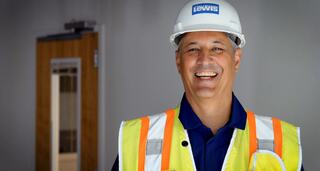
In 1989, Lewis senior superintendent Shane Weller’s grandfather Bill brought him to the Boeing Red Barn at Seattle’s Museum of Flight.
The structure, the country’s oldest surviving aircraft factory, held special meaning for the Weller family. It was there that Bill closed out his carpentry career in 1983, working on the barn’s restoration before retiring. And the project’s superintendent was none other than Shane’s father and Bill’s son.
As they walked the two-story structure and its exhibits that day, Bill would stop to show his 18-year-old grandson a detail here and a challenge overcome there.
“Well, what’d you think?” he asked Shane when it was time to go. “Want to be a carpenter?”
“Well, sure!” Shane remembers answering.
That same afternoon, they drove to the Carpenters’ Union Building together, where Shane signed up to become a member. In doing so, he set himself on a path to becoming a third-generation builder. (His uncle was also a carpenter.)
“I didn’t know what I was going to do with my life,” Shane recalls. “It felt like a good thing and it’s turned out to be a great career.”
Shane joined Lewis as a carpenter in 1999, first working on the Seaboard Building renovation project in downtown Seattle before being promoted to foreman. In 2002, he took over as superintendent at Fred Hutchinson Cancer Center. He’s been a fixture there ever since.
While most superintendents tend to move on after projects are complete, Shane has chosen to stay on and support Fred Hutch.
The variety of the work and the mission have kept him coming back.
“I really feel strongly about what I do here,” he said on a recent Thursday morning from a rooftop deck that overlooks Lake Union. “Helping cure cancer—it’s pretty awesome. It’s not just building a building and walking away. In this work, we’re helping people live.”
In 1989, Lewis senior superintendent Shane Weller’s grandfather Bill brought him to the Boeing Red Barn at Seattle’s Museum of Flight.
The structure, the country’s oldest surviving aircraft factory, held special meaning for the Weller family. It was there that Bill closed out his carpentry career in 1983, working on the barn’s restoration before retiring. And the project’s superintendent was none other than Shane’s father and Bill’s son.
As they walked the two-story structure and its exhibits that day, Bill would stop to show his 18-year-old grandson a detail here and a challenge overcome there.
“Well, what’d you think?” he asked Shane when it was time to go. “Want to be a carpenter?”
“Well, sure!” Shane remembers answering.
That same afternoon, they drove to the Carpenters’ Union Building together, where Shane signed up to become a member. In doing so, he set himself on a path to becoming a third-generation builder. (His uncle was also a carpenter.)
“I didn’t know what I was going to do with my life,” Shane recalls. “It felt like a good thing and it’s turned out to be a great career.”
Shane joined Lewis as a carpenter in 1999, first working on the Seaboard Building renovation project in downtown Seattle before being promoted to foreman. In 2002, he took over as superintendent at Fred Hutchinson Cancer Center. He’s been a fixture there ever since.
While most superintendents tend to move on after projects are complete, Shane has chosen to stay on and support Fred Hutch.
The variety of the work and the mission have kept him coming back.
“I really feel strongly about what I do here,” he said on a recent Thursday morning from a rooftop deck that overlooks Lake Union. “Helping cure cancer—it’s pretty awesome. It’s not just building a building and walking away. In this work, we’re helping people live.”
Predawn wakeups
A typical weekday for Shane begins with a 2:45 a.m. alarm, a 20-minute drive to work, and a 4 a.m. arrival at Fred Hutch’s 15-acre South Lake Union campus.
The reason for such an early start time? To check in with the Lewis foremen ending their overnight shifts while settling in and welcoming a new crew.
This synchronized effort is meant to make the entire team as “invisible” as possible during the busiest times on campus and to minimize construction-related disruptions for patients and families, researchers, clinicians, and staff members.
Lewis and subcontractors UMC and Prime Electric are co-located in a wedge-shaped building that borders Fairview Avenue. The office is built into an interstitial space between the first and second floors. Shane jokes that it’s a lot like the 7 ½th-floor in the cult classic film “Being John Malkovich.” (Unlike in the movie, however, this office has perfectly normal floor-to-ceiling-heights, and plenty of overhead clearance for the six-foot-three Shane.)
Sometimes, people who aren’t familiar with the team or its portfolio of work ask about Lewis’ “Fred Hutch project,” to which project manager Jacki Dunlap usually responds, “Which one?” She gestures in the direction of a hanging dry-erase board in the office, which lists more than 20.
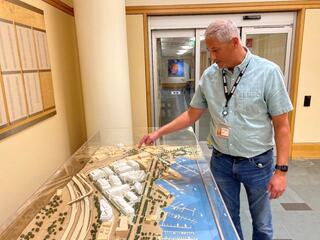
Lewis superintendent Shane Weller surveys a model of the Fred Hutchinson Cancer Center’s South Lake Union campus, where Lewis has had an active presence since 1999.
Enduring impact
Many of the buildings on the Fred Hutch campus are now several decades old. Lewis has re-roofed most of them and is responsible for ongoing enhancements.
As the lead superintendent on Lewis’ sustaining work at Fred Hutch, Shane engages directly with clinicians and principal investigators who are at the forefront of groundbreaking discoveries.
His first ever project involved renovating a space for research on threespine stickleback fish. He’s since worked with investigators including Dr. Mark Roth, past winner of a MacArthur “Genius Grant,” whose team is looking at how suspended animation can transform emergency medicine.
When it comes to research facilities, Lewis helps adapt and reconfigures labs when new teams form or when new ways of working emerge. This includes the recent push for flexible spaces that can better accommodate the pace of innovation and more collaboration between interdisciplinary teams.
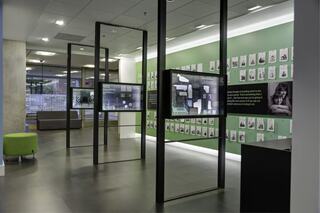
A look at Fred Hutch’s Welcome Center, built by Lewis in 2016.
Lewis has also taken on other types of projects over the years, like building an all-new welcome center, and installing a 60-foot glass-and-metal sculpture called “Vessel” in a roundabout that’s since become a focal point of Fred Hutch.
A few months into the COVID-19 pandemic, Lewis transformed the Minor Building into the 10,000-square-foot COVID-19 Clinical Research Center, or CCRC, a standalone research facility for clinical trials aimed at finding effective therapeutics and interventions. The clinic opened in October 2020.
“It’s always different,” Shane says of the company’s work at Fred Hutch at any given time. “Always.”
In addition to these projects, Lewis also helps with other tasks, like installing loaned artwork and larger art installations that adorn many of the hallways on campus.
One such piece is the 2008 painting “Gunn Ranch” by Seattle artist Mindi Katzman, which hangs on the first floor of the Arnold Building. It shows a bright red barn nestled in a meadow near Okanogan-Wenatchee National Forest. While hanging the piece, now-retired Lewis foreman Paul Brown casually mentioned to Shane that he’d painted it.
“You painted that?” Shane remembers asking.
“Not the painting, the barn in the painting!” Paul said.
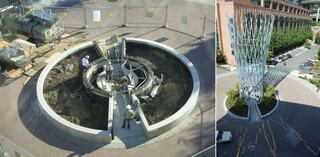
Starting in 2007, Lewis helped install architectural sculptor Ed Carpenter’s 60-foot-tall glass-and-metal “Vessel,” which has become a focal point of Fred Hutch’s South Lake Union campus.
Clocking out
On a recent afternoon, Shane walked through the doors of the Arnold Building and in passing, exchanged hellos with people he sees day in and day out: receptionists, the security team, clinicians, and other staff.
After more than 20 years on the job there, he explains, there are very few nooks he hasn’t explored. Recently, it came to his attention that there was a storage closet he’d never opened.
“There’s a good reason for that: no one keeps anything in there,” he joked.
In the fall and winter months, Shane will usually head home at 2 p.m. after handing off ‘night notes’ to the overnight team. In the summertime, he’s been known to bring his standup paddleboard to Lake Union for a four-mile outing before the evening commute.
Once, while at dinner nearby with Lewis colleagues after work, a radiant purple glow bathed the outdoor seating area of the restaurant where they were sitting. The setting sun was reflecting off the four-story sculpture that the team had installed across the street in 2008. Not a bad sendoff after a long day’s work.
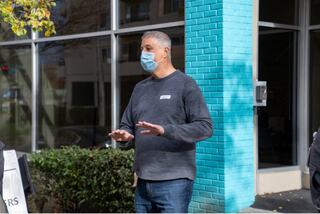
Shane stands outside the Fred Hutch Minor Building in 2021 and reflects on the completion of the CCRC inside.